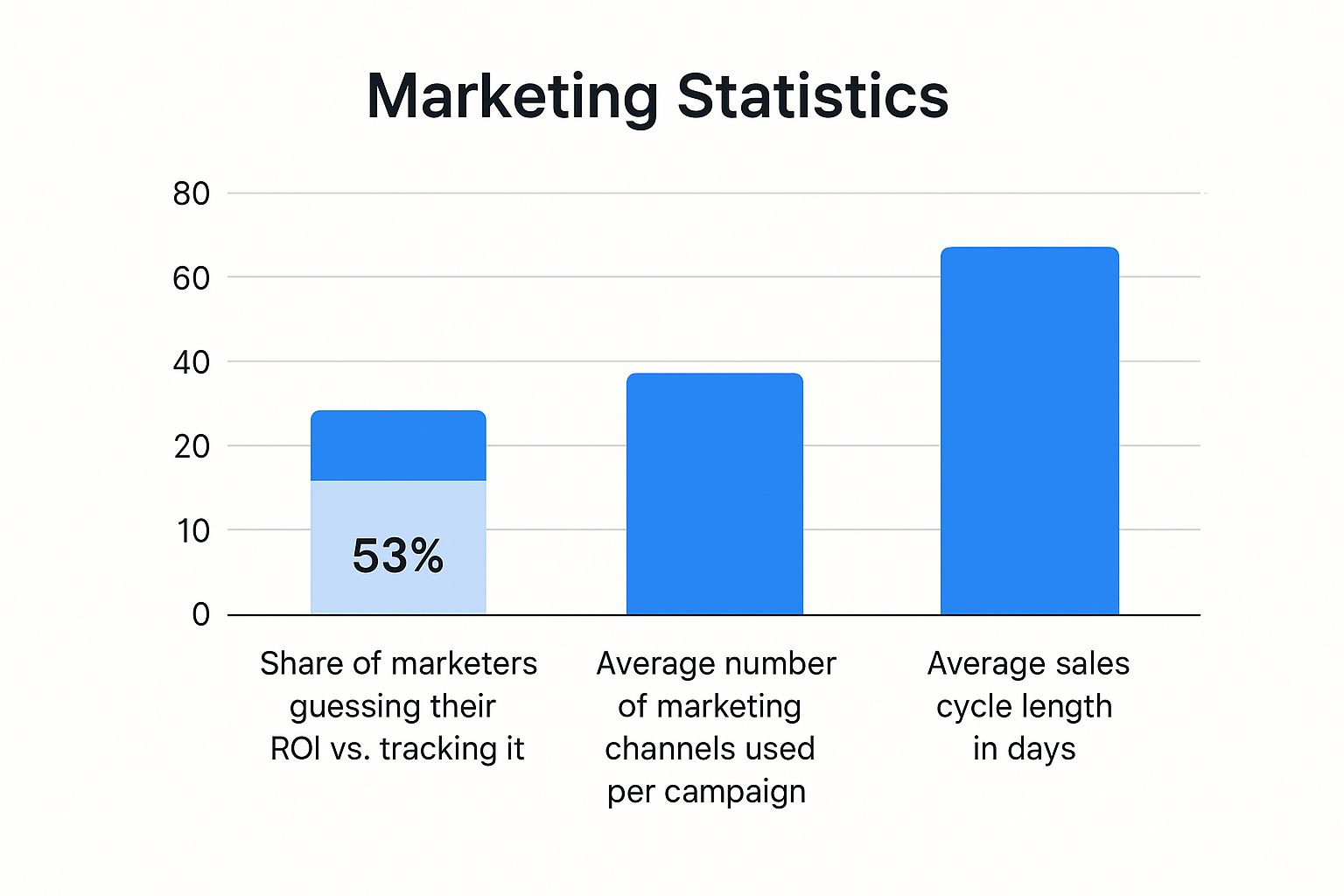To measure marketing ROI, you need to figure out the financial return from your marketing efforts compared to what you spent. It's about tracking the revenue that comes from your campaigns and subtracting your total marketing investment. The real key, though, is to move beyond simple vanity metrics and understand which specific channels and touchpoints are actually driving sales.
Every marketer feels the heat to justify their budget. In a world of complex, winding customer journeys, being able to show your impact is no longer a "nice-to-have"—it's non-negotiable.
Forget the textbook definitions for a second. Measuring ROI is the single most important conversation you can have with your leadership. It’s what separates the teams seen as a "cost center" from those celebrated as a revenue driver.
But let's be real, the day-to-day challenges make this feel like a huge task. You're probably juggling campaigns across a dozen channels, from paid ads to content, all while dealing with long sales cycles that make it nearly impossible to connect that first click to the final sale. When your analytics are a mess, it's easy to miss the signs you need better marketing analytics.
Key Takeaway: Guessing your marketing ROI isn't just a bad habit—it's a direct path to wasted spend, missed opportunities, and an inability to prove your team's value to the business.
The pressure isn't letting up; it's getting more intense. By 2025, a staggering 83% of marketing leaders say that demonstrating ROI is their absolute top priority.
Here's the problem: only 36% of marketers feel they can actually measure it accurately. Nearly half admit they struggle to track it across multiple channels. That disconnect is where budgets get cut and opportunities are lost.
This chart really drives home the challenges marketers are up against, from the percentage who are just guessing their ROI to the sheer number of channels they're trying to manage.

The data is clear: as channels multiply and sales cycles get longer, guesswork becomes the default. And that's a dangerous game to play.
The good news? You don't have to guess. Mastering ROI is totally achievable when you have the right framework and the right tools. This guide will give you the practical, no-fluff solutions you need to prove your value and start driving real, strategic growth.

Before you can confidently answer the question, "What was our ROI?", you need to lay some groundwork. Real measurement isn't about jumping into flashy dashboards; it's about defining exactly what you're trying to measure in the first place.
It all starts with the classic formula, a simple but powerful anchor for your entire strategy:
((Net Profit - Marketing Cost) / Marketing Cost) x 100
Seems straightforward, right? But the devil is in the details.
Marketing Cost is more than just your ad spend. It’s everything—your team’s salaries, software subscriptions like Cometly, and even the cost of creating content. Getting a complete, honest picture of your investment is the only way to calculate a real ROI.
Then there's Net Profit, which is the revenue directly generated by your marketing. This is often the trickiest piece to nail down. It requires connecting specific campaigns to actual sales, a challenge that gets more complicated with every new channel you add to the mix.
The "return" in ROI isn't always a direct sale, and your first job is to decide what a successful outcome actually looks like for your business. Does every single campaign need to drive an immediate purchase, or are you playing a longer game?
Here are a few ways to think about "return":
By defining your "return" upfront, you create a clear target. This one step saves you from the chaos of trying to measure everything and instead focuses your energy on the outcomes that actually move the needle.
Once you know what success looks like, you need to pick the right Key Performance Indicators (KPIs) to track your progress toward it. A classic mistake is using the same metrics for every channel. The numbers that matter for a Google Ads campaign are worlds apart from what you’d track for an organic content strategy.
A great way to approach this is to match specific KPIs to your marketing goals.
To make this tangible, here’s a breakdown of how different goals connect to different KPIs. Notice how the primary KPI measures the direct outcome, while the secondary KPIs give you context and help you troubleshoot.
As you can see, each goal has its own scorecard. This ensures you're judging each channel by its actual purpose, not forcing a one-size-fits-all metric onto everything.
To get the full picture, you have to unify data from all these different sources. We've written before about the best practices for marketing data integration, which is crucial for seeing how a connected system provides much clearer insights.
By matching the right metric to the right channel, you build a measurement plan that tells the complete, accurate story of your marketing performance.

Let's be blunt: without the right tech, any attempt to measure marketing ROI is just a glorified guessing game. Your tech stack is the central nervous system of your measurement strategy. It’s what captures all the data you need to finally connect your marketing spend to actual, tangible revenue.
Building a powerful stack isn't about throwing money at enterprise-level software. It’s about starting with a few non-negotiable fundamentals that give you a baseline view of your customer’s journey from start to finish.
Every single business, regardless of size or industry, needs a solid foundation for tracking. Think of these tools as the absolute bare minimum for seeing how people interact with your brand online and how those interactions eventually turn into paying customers.
These two platforms work in tandem to give you a basic map of the journey from first click to final sale. Without them, you’re flying completely blind.
Once your foundation is solid, the next layer is tracking individual campaigns with precision. This is where UTM parameters become your absolute best friend.
UTM parameters are simple little tags you add to the end of your URLs. They tell your analytics tools exactly where a visitor came from, allowing you to easily differentiate traffic from a specific Facebook ad versus a link in your weekly email newsletter.
Pro Tip: Create a standardized UTM-building spreadsheet for your entire team. This prevents inconsistent naming conventions (e.g., "facebook" vs. "FB") that can fragment your data and make accurate reporting a nightmare. Consistency is everything when it comes to clean, reliable campaign data.
In a world filled with increasing privacy restrictions and ad blockers, relying solely on traditional, browser-based tracking just doesn't cut it anymore. To get a truly accurate picture of your performance, you have to adopt more advanced solutions that aren't so easily disrupted by data loss. This is a critical factor when choosing from the best marketing analytics tools for success.
Two technologies are absolutely critical here:
Putting these tools in place helps you reclaim lost data. The result? More accurate attribution, better ad platform optimization, and a much, much clearer understanding of your true marketing ROI. They transform your tech stack from a simple reporting tool into a robust system built for growth.
The modern customer journey is rarely a straight line. A buyer might see a TikTok ad, read a blog post a week later, get a retargeting ad on Facebook, and finally click a link in an email newsletter to make a purchase.
So, which touchpoint gets the credit for the sale? This is the core challenge of marketing attribution.
Choosing an attribution model is how you decide to assign value to these different interactions. Your choice has massive implications for how you measure marketing ROI because it directly influences which channels appear successful and which ones look like they're underperforming.
Get it wrong, and you could end up cutting the budget for a channel that's quietly driving all your initial brand discovery.
The simplest models give 100% of the credit to a single touchpoint. While they’re easy to implement, they often paint a dangerously incomplete picture of what’s actually working.
Imagine a customer first discovers your brand through an organic social media post. Weeks later, they see a Google Ad, click it, and buy. A last-touch model would give 100% of the credit to the Google Ad, making social media look worthless even though it started the entire journey.
Since no single touchpoint tells the whole story, multi-touch attribution models distribute credit across the entire customer journey. This provides a more nuanced and realistic view of your marketing performance, helping you make smarter budget decisions.
You can get a deeper understanding by exploring this detailed comparison of attribution models for marketers.
Key Insight: Shifting from single-touch to multi-touch attribution is like switching from a single snapshot to a full-length movie of your customer's journey. You see the entire plot, not just the final scene, which is essential for accurate ROI measurement.
Some popular multi-touch approaches include:
For businesses with larger budgets and complex, multi-channel strategies, even standard multi-touch models can have blind spots. This is where more advanced methods like Marketing Mix Modeling (MMM) come into play.
MMM uses statistical analysis to determine how different marketing investments, including offline activities and brand campaigns, contribute to revenue over time. It’s a powerful approach for getting a high-level, strategic view of your entire marketing ecosystem.
In fact, its adoption is growing rapidly; by 2025, it's projected that around 49% of marketers will use MMM, with 47% planning to invest in it soon. You can discover more insights about these marketing ROI statistics. This method helps connect all marketing activities to sales, giving you a truly complete picture of your ROI.

Collecting data is only half the battle. The real value in measuring marketing ROI comes when you turn those numbers into smart, strategic decisions that actually fuel growth. Raw data is just noise; insightful action is what moves the needle.
This process transforms measurement from a backward-looking report card into a forward-looking roadmap. It’s about building a continuous feedback loop: measure, analyze, optimize, and repeat.
Not everyone in your organization needs to see the same report. To make your data impactful, you have to tailor the narrative to your audience. What a C-level executive cares about is vastly different from what a channel manager needs to optimize their campaigns.
By speaking their language, you ensure the data gets used instead of just being filed away. It's about turning insights into actionable data that empowers your entire team to make better choices.
With clear, reliable ROI data, you can finally move beyond gut feelings and make objective calls about where your budget should go. The goal is simple: systematically shift resources from low-performers to high-performers.
Start by sorting your channels and campaigns from highest to lowest ROI. This simple act often reveals surprising truths about where your money is actually working. You might discover a "boring" channel is quietly outperforming a flashier one.
When you look at channel-specific performance, the differences can be stark. For instance, email marketing often delivers a massive $42 for every $1 spent, while SEO provides a strong long-term return of $22.24 per $1 invested. Paid search, though reliable, typically returns a more modest $2 for every dollar.
Your ROI report is your playbook for resource allocation. Double down on what’s working, and don't be afraid to cut or completely rethink the channels that are draining your budget with minimal returns.
But what about the channels that don't drive direct sales? Some, like organic social media or top-of-funnel content, rarely show a direct, last-click ROI. Their value is often more subtle, influencing prospects early in their journey. Don't write them off just because they don't have a direct ROAS.
Instead, look at their contribution through a multi-touch attribution lens.
Understanding this indirect influence is crucial for getting a complete picture. It prevents you from cutting off the very channels that are filling the top of your funnel and building brand trust over time. This holistic view is what separates good marketers from great ones—using ROI data to build a resilient, high-impact marketing machine.
Even with a solid game plan, you're bound to hit a few snags when you start digging into the data. Let's be honest, measuring marketing ROI isn't always a clean, A-to-B process. It's messy.
Here are a few of the most common hurdles I see marketers run into, with some straight-up advice on how to clear them.
This is the big one, right? The question that keeps marketers up at night. How in the world do you put a dollar value on channels that don't drive an immediate, trackable sale? Think organic social, brand content, or PR.
The trick is to stop thinking about direct ROI and start looking for influenced ROI.
Instead of hunting for that last-click conversion, your job is to show how these channels play a supporting role in the bigger picture.
The goal isn't to prove that a single Instagram post led to a sale. It's to prove that your top-of-funnel efforts are building trust and filling the pipeline, even if another channel gets the final credit.
There's no magic number here. The right reporting cadence is all about the channel you're measuring and the length of your sales cycle. If you try to apply a one-size-fits-all approach, you'll end up making reactive, short-sighted decisions.
For your fast-moving channels like paid ads, you need to be in there daily or weekly. Things like ROAS and CPA can swing wildly in a matter of hours, and you have to be ready to pivot your ad spend almost instantly.
But for your long-game strategies—think SEO or content marketing—pulling the plug after a few weeks would be a massive mistake. These channels are slow burns that need time to build momentum. A monthly or quarterly check-in will give you a far more accurate read on their performance and let those compounding efforts actually pay off.
Your reporting frequency has to match the channel's natural rhythm. If you try to measure a slow-burn strategy with a short-term lens, you're guaranteed to draw the wrong conclusions.
If you're a small business or just have a tight budget, don't try to boil the ocean. You'll just get overwhelmed. The smart move is to pick one or two channels with the most direct path to revenue and absolutely master them.
For most businesses, that means starting with:
And don't forget the power of social influence. A staggering 81% of consumers make spontaneous purchases based on what they see on social platforms several times a year. Even if you can't track every single interaction, knowing these trends helps you make smarter bets. You can find more insights on this in Sprout Social's report on social media's marketing ROI statistics.
Get the basics right in these high-impact areas first. You can always expand your measurement game as you grow.
Ready to stop guessing and start knowing your true marketing ROI? Cometly unifies all your marketing data into one powerful platform, giving you the clarity to eliminate wasted spend and scale what works. See how Cometly can transform your marketing analytics today.
Learn how Cometly can help you pinpoint channels driving revenue.
.svg)
Network with the top performance marketers in the industry